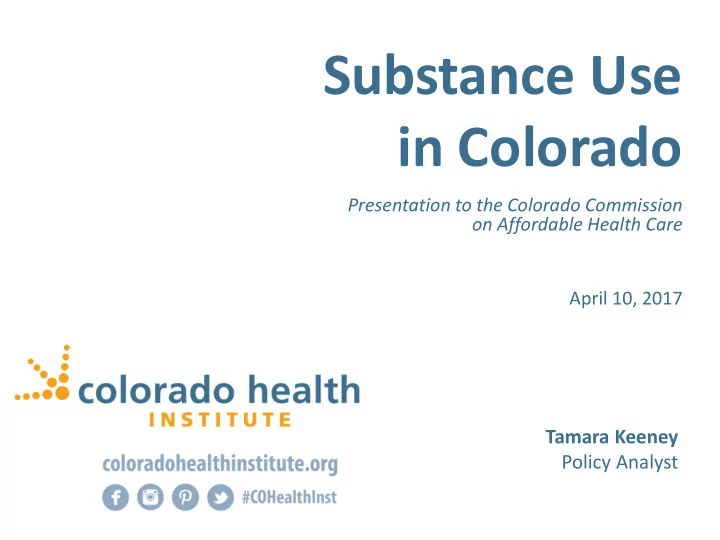

Substance Use in Colorado Presentation to the Colorado Commission on Affordable Health Care April 10, 2017 Tamara Keeney Policy Analyst
Takeaways 1. Overdose deaths in Colorado are rising, driven by an increase in opioid-related deaths. 2. The biggest gaps in treatment are related to an insufficient workforce. 3. A small percentage of spending for substance use disorder is for treatment. 4. Activities in Colorado to increase treatment are underway, but opportunities remain. 2
Source: CHI analysis of CDC National Vital Statistics System Mortality Data
Source: CHI analysis of CDC National Vital Statistics System Mortality Data
Opioids Are Driving the Rise in Overdose Deaths Source: CDPHE Vital Statistics
Alcohol is the Most Common Reason for Treatment 2015 Treatment Admissions by Drug Source: Drug/Alcohol Coordinated Data Systems, Office of Behavioral Health, Colorado Department of Human Services
Substance Use Care Continuum Early Intervention Enhancing Health Recovery Support Primary Prevention Treatment Source: The Surgeon General’s Report on Alcohol, Drugs and Health (2016).
Colorado has a shortage of treatment services. Coloradans in need of substance use treatment services who receive them. Sources: NSDUH (2015), Jones (2015), Keystone Policy Center analysis of LinkingCare.org (2016)
Source: Keystone Policy Center analysis of LinkingCare.org
Source: Keystone Policy Center analysis of LinkingCare.org
Medication-Assisted Treatment • MAT is an evidence-based approach to treating opioid dependence • Combination of medication plus other social support services, such as counseling. • Clinically effective by helping reduce the potential for relapse. • Better adherence to programs than those without medication. Source: Volkow, N. et al (2014)
Source: SAMHSA treatment locator.
Cost To the System: All Substances • Economic burden of substance use (2015) $700 billion/year Health Care Overall Tobacco $130 billion $295 billion Alcohol $125 billion $224 billion Illicit Drugs $11 billion $193 billion Source: NIDA (2015)
Cost To the System: Prescription Opioids Distribution of the Economic Burden of Prescription Opioid Overdose, Abuse and Dependence Source: Florence et al 2013
Research on Treatment is Strong • Treatment of substance use disorders is effective in decreasing medical cost and substance use. • When savings related to health care are added to savings to other systems, total savings can exceed costs by a ratio of 12:1. Sources: Walter et al (2005); Mojabai and Zivin (2003) Health Services Research; NIDA (2012)
Cost Savings: Medication-Assisted Treatment • Methadone • Treatment for opioid addiction with methadone return of $4-5 for every $1 invested. • Buprenorphine • Treatment group saw overall reduced health care expenditures compared to non-adherent group. • Found to reduce emergency department utilization, but not hospitalization. Sources: Center for Substance Abuse Treatment (2005); Tkacz (2014); NIDA (2012); Schwarz (2012)
Timeline of Recent Policies • 2008: Prescription Drug Monitoring Program (PDMP) goes live • 2008: Mental Health Parity and Addiction Equity Act • 2013: Colorado Consortium on Rx Abuse established • 2015: Naloxone standing orders • 2016: Comprehensive Addiction and Recovery Act • 2016: 21 st Century CURES
Current Colorado Legislation • SB74 Create Medication-Assisted Treatment Pilot Program • SB146 Access to Prescription Drug Monitoring Program • SB193 Research Center for Prevention of Substance Abuse Addiction
Ideas from Other States • New Jersey Parental consent • Massachusetts Seven day limit on pain pills • Vermont Hub and spoke model • California 1115 waiver for continuum of care
Other Activities in Colorado • Colorado Consortium on Prescription Drug Abuse Prevention • Office of Behavioral Health Needs Assessment • Keystone Policy Center Stakeholder Assessment • Substance Abuse Trend and Response Task Force
Potential Recommendations • Market advisory recommendations • Enforce parity • 1115 waiver for continuum of care • Support pilots to expand access • Workforce education and training
References Center for Substance Abuse Treatment (2005). Medication assisted treatment for opioid addiction in opioid • treatment programs. Treatment Improvement Protocol (TIP) Series 43. HHS Publication No. (SMA) 14-4892R. Rockville, MD. Substance Abuse and Mental Health Services Administration. Florence, CS et. al. (2013) The Economic Burden of Prescription Opioid Overdose, Abuse, and Dependence in the • United States. Medical Care: 54 (10). Jones, Christopher M,PharmD., M.P.H., Campopiano, M., M.D., Baldwin, Grant,PhD., M.P.H., & McCance-Katz, E. • (2015). National and state treatment need and capacity for opioid agonist medication-assisted treatment. American Journal of Public Health, 105 (8), E55-E63. Mojtabai, Ramin, and Joshua Graff Zivin. "Effectiveness and Cost-effectiveness of Four Treatment Modalities for • Substance Disorders: A Propensity Score Analysis." Health Services Research 38.1p1 (2003): 233-59. National Institute on Drug Abuse. Principles of Drug Addiction Treatment: A Research-Based Guide (Third Edition), • National Institutes of Health, 2012. Schwarz, Ryan, et al. “Retention on buprenorphine treatment reduces emergency department utilization, but not • hospitalization, among treatment-seeking patients with opioid dependence.” Journal of Substance Abuse Treatment. Volume 43, Issue 4, Pages 451–457. December 2012. Tkacz, Joseph, et al. “Relationship Between Buprenorphine Adherence and Health Service Utilization and Costs • Among Opioid Dependent Patients.” Journal of Substance Abuse Treatment. Volume 46, Issue 4, Pages 456–462. April 2014. US Department of Health and Human Services, Office of the Surgeon General, Facing Addiction in America: The • Surgeon General’s Report on Alcohol, Drugs and Health. Washington, DC: HHS, November 2016. Volkow, Nora D., Thomas R. Frieden, Pamela S. Hyde, and Stephen S. Cha. "Medication-assisted Therapies-- • tackling the Opioid-overdose Epidemic." The New England Journal of Medicine 370.22 (2014): 2063. Walter, Lawrence J., Lynn Ackerson, and Steven Allen. "Medicaid Chemical Dependency Patients in a Commercial • Health Plan: Do High Medical Costs Come down over Time?" The Journal of Behavioral Health Services & Research 32.3 (2005): 253-63.
Recommend
More recommend